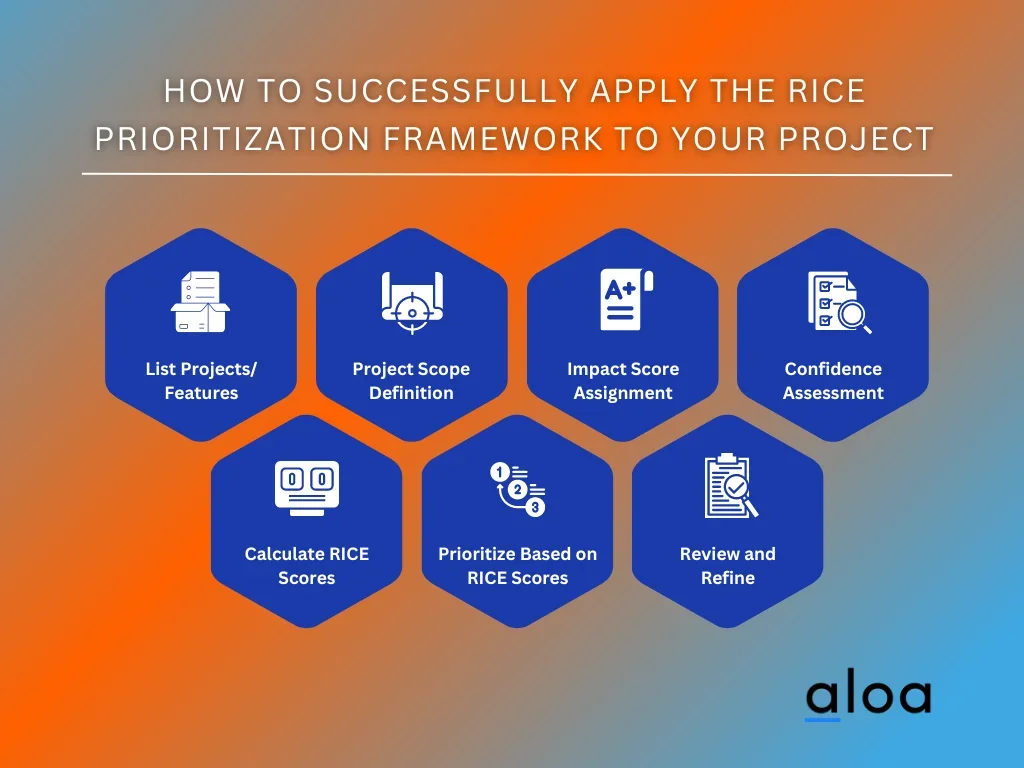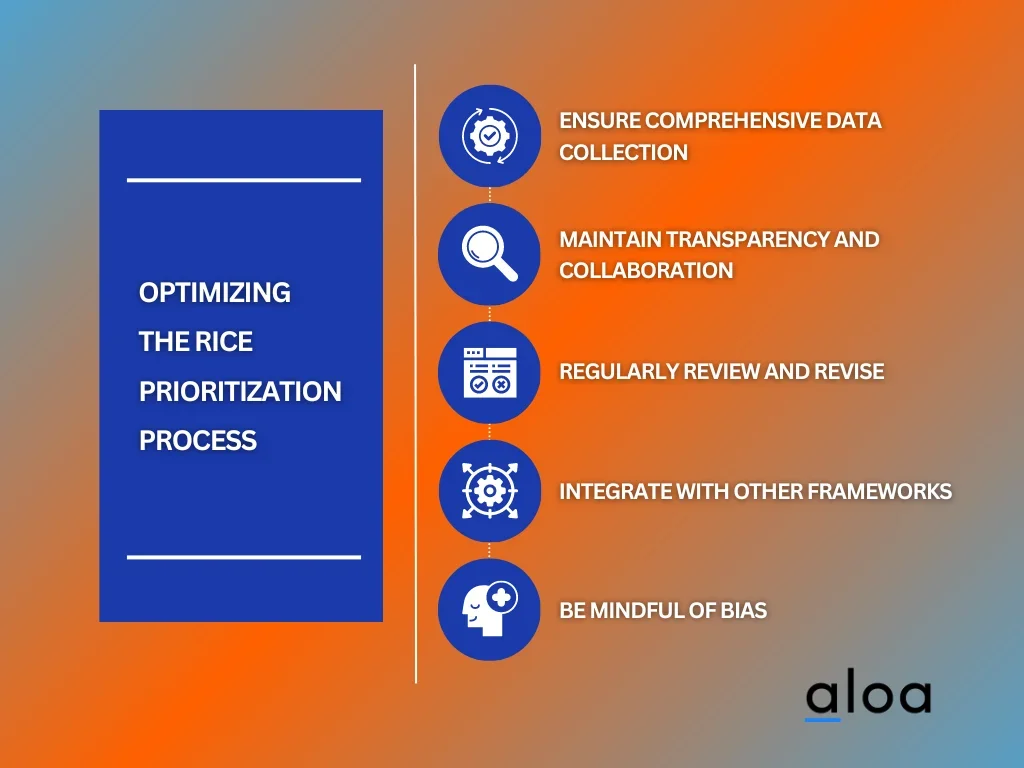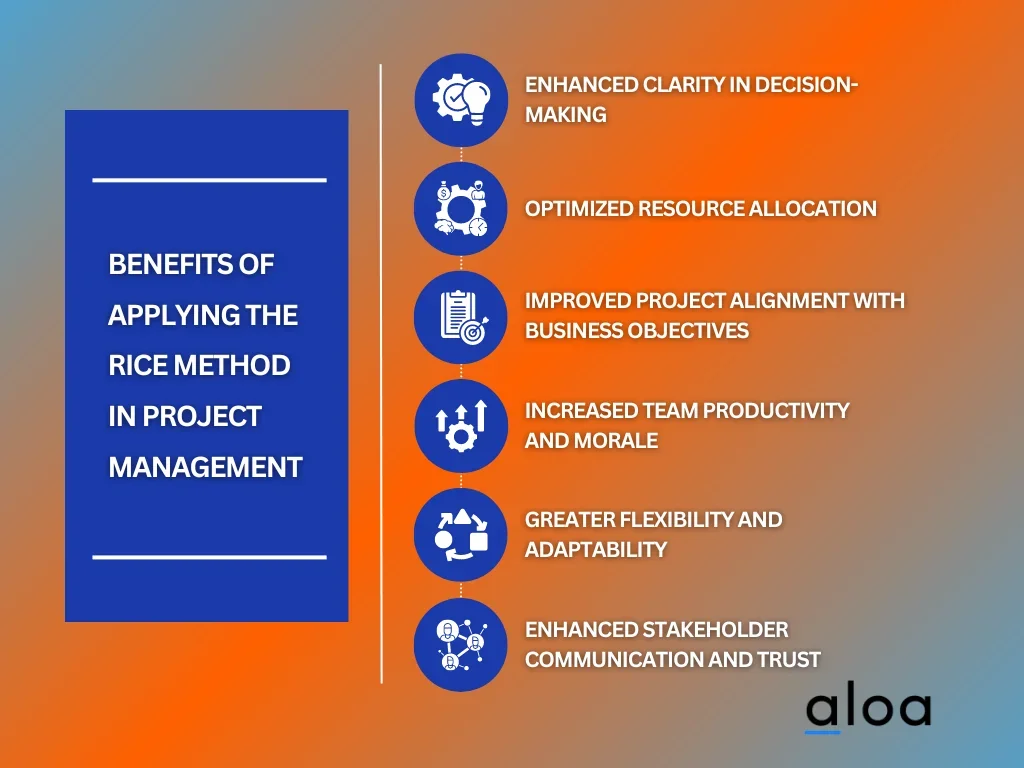The RICE prioritization framework, also known as the RICE framework, is a beacon for project managers in steering their teams toward success. With the goal of prioritizing projects that promise the most value, this framework provides a clear criteria based on four key factors - Reach, Impact, Confidence, and Effort (RICE).
Aloa, a software outsourcing expert, understands the significance of integrating the RICE framework into project management. Drawing from our expertise in product development, we recognize the transformative impact of properly applying this framework. With our insightful inputs, project managers can utilize their resources efficiently based on their strategic goals.
In this blog, we'll explore the RICE prioritization framework in depth, unpacking its potential as a transformative project management tool for startups. We'll cover every aspect, from its fundamental principles to practical tips for effective implementation, providing you with a comprehensive guide to harnessing RICE for maximum project impact.
Let's get started!
What Is the RICE Prioritization Framework in Project Management?
The RICE prioritization framework is a systematic approach used in software development and product management to identify and prioritize the most valuable tasks. Its primary goal is to allocate resources efficiently and maximize return on investment (ROI), allowing teams to achieve success while ensuring alignment with business objectives.
The acronym RICE stands for Reach, Impact, Confidence, and Effort. Each component serves a distinct purpose in assessing potential projects or features likely to deliver the highest impact. Leveraging this mechanism transforms project managers into strategic decision-makers who make informed decisions that benefit their project's success.
Here’s a brief overview of each RICE component to aid your decision-making processes:
Reach
'Reach' is the measure of the number of people or situations that will be affected by a feature or project within a specific timeframe. This allows project managers to understand the breadth of influence a potential project can have. It's typically measured numerically, such as the number of users or clients affected per time period. This aspect can be critical in determining the prioritization of projects that have substantial user involvement or influence.
Impact
'Impact' evaluates the potential change or effect every person or situation will experience once the feature or project is executed. This is generally estimated on a dimensionless scale from 0.25 (minimum impact) to 3 (maximum impact). Higher-impact projects often take precedence as they can significantly benefit users or increase business objectives.
Confidence
'Confidence' assesses certainty or faith in the figures used to calculate ‘Reach’ and ‘Impact.’ It's usually quantified as a percentage, with a higher percentage suggesting a higher level of assurance in the accuracy of the provided estimations. Factors such as data availability, resemblance to past projects, and reliance on assumptions influence the ‘confidence’ score.
Effort
The 'Effort' parameter quantifies the total work necessary to implement a feature or a project. This value is commonly expressed in terms of time (days, weeks, or months) a team spends completing a project. Ideal projects have higher reach, impact, and confidence but relatively lower effort.
How To Successfully Apply the RICE Prioritization Framework to Your Project
The efficient organization of projects and features based on their intrinsic value poses a significant challenge. In such scenarios, adopting the RICE prioritization framework can significantly simplify the process, leading to more informed decision-making.

Let’s explore the step-by-step guide to leverage this framework successfully.
Step 1: List All Potential Projects or Features
An essential preliminary step in leveraging the RICE framework is to bring together a diverse set of project ideas. This is where you engage with team members from different departments (e.g., sales, customer service, technology). Doing so will help them get a broad perspective on potential projects or features. This inclusivity ensures a diverse set of ideas is considered from the outset.
- Use Collaborative Tools: Leverage tools like Trello and Asana to document and manage project ideas, ensuring diverse perspectives are captured from the outset.
- Develop Detailed Plans: These plans serve as roadmaps for successful project execution of the highest priority projects, including milestones, needed resources, and potential risks.
- Maintain Flexibility: Be prepared to adapt and pivot your plans as necessary to accommodate unforeseen changes without derailing your projects.
Step 2: Define the Reach for Each Project
After establishing your projects' objectives, the second step involves determining each potential initiatives reach. In this step, you quantify the number of individuals or transactions affected. This is crucial as it helps in effectively allocating resources, setting realistic goals, and measuring the impact of your initiatives on your target market.Defining the Reach involves:
- Applying Accurate Data: Utilize the most precise data at your disposal to determine the reach of your project. Acquiring accurate data ensures a well-informed and successful project strategy.
- Identifying Key Metrics: Clearly defining these metrics enables accurate scoring and prioritization of project ideas. Look for active user numbers for engagement or analyze historical sales data when projecting potential revenue growth.
- Defining Timeframe for Reach: Specify the reach timeframe accurately. A feature might reach 10,000 users a month, but if its effects only last a few months, the timeframe for calculating its Reach should reflect this.
Step 3: Assign Impact Scores to Each Project
Utilizing a standard scale is crucial to clearly define what each score represents, ensuring that your team maintains consistency across evaluations. This standardization is crucial as it establishes a clear framework for comparison, allowing for more objective decision-making and ensuring that resources drive the greatest potential impact.
For example, the Impact scores might be categorized as follows:
- 0.25 - minimal impact
- 1 - low impact
- 2 - medium impact
- 3 - high impact
Using data from similar past projects, in addition to customer surveys and market research, can inform your impact scores. This methodical approach quantifies the value of each project and ensures strategic alignment with business goals, optimizing resource allocation and maximizing efficiency.
Step 4: Determine Confidence Levels
Determining ‘Confidence’ levels is a critical stage where we assess the reliability of our predictions for each project. Confidence can sometimes be abstract, so it helps to establish what each percentage range signifies. To help you out, here’s a sample of the Confidence level scale, which means:
- 90-100%: High Confidence - Estimates are backed by historical data, rigorous analysis, and proven methodologies, leading to a high degree of certainty in the predicted outcomes.
- 70-89%: Moderate Confidence - Analysis is based on historical data, industry benchmarks, and informed assumptions from subject matter experts. While not guaranteed, the predictions are reasonably reliable.
- 50-69%: Low Confidence—The level of uncertainty is relatively high, and the predicted outcomes should be viewed as approximations. Thus, estimates are largely speculative, based on limited data points, broad assumptions, or hypotheses.
Step 5: Calculate the RICE Score for Each Project
A RICE Score is a strategic tool designed to evaluate and prioritize projects based on their potential value and impact. Calculating the RICE score is essential for organizations aiming to allocate resources efficiently and achieve the highest project return on investment. It provides a quantifiable method for prioritizing projects based on their expected benefits versus the required investment. Here’s an essential guide:
- Use Comprehensive Effort Estimation: Include all aspects of work—planning, development, testing, and deployment. Often, teams underestimate the effort by forgetting to account for non-development tasks.
- Follow Conservative Effort Estimates: If you're not certain about the effort, it’s safer to round up your estimates. This accounts for the almost inevitable surprises that lengthen project timelines.
- Take Efficient Calculation Process: Use a spreadsheet to automatically calculate the RICE scores as you fill in Reach, Impact, Confidence, and Effort. This makes the process more efficient and reduces the chance of manual error.
Once you have calculated the Effort, you can complete your RICE score calculation by integrating it with the other components - Reach, Impact, and Confidence. This comprehensive approach delineates the RICE Scoring Method, facilitating a systematic and objective framework for evaluating project potential success and prioritization.
Let’s delve into more detail about this below.
RICE Scoring Method
The RICE scoring method enables project managers and teams to make data-driven decisions. This helps them focus on projects that deliver the highest value relative to their effort. Here's the scoring method to bring Reach, Impact, and Confidence all together:
- Reach (R): Estimate the number of people or transactions affected over a specific timeframe.
- Impact (I): Determine the project's effect on those it reaches on a scale from 0.25 to 3.
- Confidence (C): Assess your confidence in your Reach and Impact estimates as a percentage.
- Effort (E): Calculate the total effort required to complete the project in person-months.
The RICE score for a project is then calculated using the formula:
[{RICE Score} = {(Reach \times Impact \times Confidence)}{Effort}]
Example Calculation:
- Reach: 5000 users per month
- Impact: 2 (on a scale of 0.25 to 3)
- Confidence: 80% (or 0.8)
- Effort: 4 person-months
[{RICE Score} = {(5000 \times 2 \times 0.8)}{4} = 2000]
This score allows for an objective comparison between projects or features, with higher scores indicating a higher priority under the RICE framework.
Step 6: Prioritize Based on RICE Scores
Once you've computed the RICE scores, plot your projects according to their RICE scores using a graph or chart. This can provide a clear visual of the most valuable projects.
Tools such as Microsoft Excel or Google Sheets can be used to create custom project management dashboard for this visualization. While RICE scores are critical, external factors such as market conditions, strategic alignment, and resource availability might influence prioritization.
Step 7: Review and Refine
Once you’re all set, conducting periodic reviews with stakeholders is necessary to gather new information and adjust the priority list. To begin with, incorporate feedback from all levels of the team. Frontline employees often have insights into projects' practicality and the potential impact that might need to be apparent at higher levels.
Following this, conduct scheduled project reviews regularly and analyze RICE scores to ensure that your priorities align with business goals and market conditions. Additionally, be prepared to shift priorities based on performance data, changing market dynamics, and company strategy evolutions. Maintaining an agile approach to the RICE framework allows for timely adjustments and maximizes the chances of project success.
Best Practices to Apply When Using the RICE Prioritization Method
The RICE Prioritization Method is an effective tool for decision-making and project management. However, to ensure its optimal utility, specific best considerations must be followed:

Ensure Comprehensive Data Collection
Accurate, robust data is the foundation of an effective RICE prioritization method. Inputs from diverse stakeholders play a crucial role in estimating your Reach, Impact, Confidence, and Effort.
Conduct market research, gather customer feedback, and assess historical data to make informed estimations. This comprehensive data collection can significantly prioritize initiatives that bring substantial value to your business.
Maintain Transparency and Collaboration
Transparency in the prioritization process cultivates trust and fosters a culture of collaboration and inclusion. So, involve team members and stakeholders in the prioritization process to build buy-in and ensure a shared understanding of decisions. Communicate how scores are calculated and the rationale behind priority rankings.
Regularly Review and Revise
The dynamic nature of business environments necessitates regular review and revision of priorities. Periodically reevaluate priorities as new information becomes available or as business objectives evolve. Be willing to adjust the weighting of the RICE components based on what proves most predictive of success.
Integrate with Other Frameworks
Incorporating RICE with other prioritization frameworks can result in a more inclusive and comprehensive evaluation. With that, consider combining RICE with qualitative methods or other prioritization frameworks to capture a broader range of insights. You may also adapt to certain methodologies to fit your organization's or project context's unique needs.
Be Mindful of Bias
Recognizing and mitigating biases is crucial in maintaining objectivity in the RICE scoring process. That said, acknowledge the subjective nature of estimates, especially in Impact and Confidence, and seek to counteract biases through diverse inputs. You may even employ techniques like blind estimation or range estimation to improve accuracy.
Benefits of Applying the RICE Method in Project Management
The RICE prioritization framework is a dynamic tool that, when applied effectively, can profoundly benefit your project roadmap. It encourages a shift from intuition-based decisions to a more structured, data-driven approach.

Here's how implementing the RICE method can benefit your project management efforts:
Enhanced Clarity in Decision-Making
Utilizing the RICE prioritization framework, project managers can gain enhanced clarity in decision-making by quantifying each task's Reach, Impact, Confidence, and Effort. The inclusion of a Confidence score within the RICE criteria elevates decision quality. This enables a preference for well-researched initiatives over less substantiated ones.
Moreover, calculating potential impact and feasibility through the Confidence measure informs managers about the practicality of their ideas. This contributes to higher RICE scores and supports more efficient decision-making, aligning closely with project goals and deadlines. A precise estimation of effort ensures optimal resource use and confirms the RICE method as a reliable roadmap for project clarity and direction.
Optimized Resource Allocation
Efficient resource use is crucial for project success. The RICE framework aids in identifying and prioritizing the tasks that promise the highest return on investment in terms of effort estimates and potential impact.
With the RICE prioritization framework, teams can allocate their resources more effectively, focusing on tasks that deliver maximum value. The RICE formula, which uses the criteria of Reach, Impact, Confidence, and Effort to score each task and formulate a final score, allows for optimized resource allocation.
Improved Project Alignment with Business Objectives
Establishing your project structure with the RICE framework embodies strategic project alignment. When project managers focus on high-impact tasks that resonate with their organization's strategic goals, every project initiative propels the company toward its objectives. Such alignment is beneficial and pivotal for long-term success, enabling them to concentrate on the most important efforts.
Increased Team Productivity and Morale
Teams work best when there's a clear direction and understanding of what needs to be done and why. The RICE prioritization framework provides this clarity and focus, which, in turn, boosts team productivity and morale. When team members see how their work directly contributes to the project's success through a ranked list of initiatives, it fosters a sense of purpose and motivation that increases productivity and satisfaction for the entire team.
Greater Flexibility and Adaptability
The structured yet flexible nature of the RICE method allows software development teams to quickly adapt to changes without losing sight of their priorities. As project landscapes change and new information emerges, project managers can re-evaluate and adjust their priorities based on current data, ensuring the project remains on track and relevant.
Enhanced Stakeholder Communication and Trust
The transparency and objectivity provided by the RICE method improve communication among stakeholders. When decisions are based on clear, quantifiable metrics, it's easier to explain and justify those decisions, thereby building trust and confidence in the project management process.
Key Takeaway
The RICE prioritization framework offers a structured way for project managers and software development teams to plan and execute their projects efficiently. Spotlighting the most impactful initiatives, this framework allows teams to channel their resources into ventures that yield the highest returns in the product management space.
The impact of the RICE prioritization model alongside agile methodology principles provides a clear and efficient method for prioritizing projects based on their value. This integration forms a cornerstone for making informed decisions about managing projects while thriving on the complex nature of project management.
Ready to harness the full potential of the RICE prioritization framework in your projects? Sign up for our email list via the Aloa blog page to stay updated on the latest insights into scaling your project management skills. We’ll keep you updated on how to apply project management models to streamline your team management and achieve project success!

